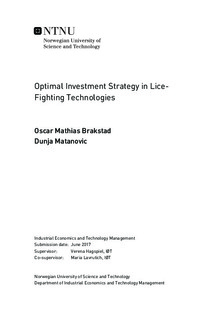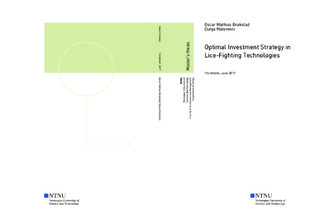| dc.description.abstract | Salmon lice is a parasite feeding off the flesh and skin of the fish, and is currently one of the largest challenges for the aquaculture industry, prohibiting growth in the industry. In order to allow for growth in an environmentally sustainable way, the Norwegian government has recently issued a set of regulatory guidelines referred to as the traffic light system, set to launch in October 2017. The regulation allows for production increase in regions with low lice levels, but forces reduction of production in regions with high lice levels, thus, motivating farmers to take additional measures to fight lice. Currently, profit margins in the industry are high, and salmon farmers are therefore investing heavily in existing lice mitigating technologies in order to deal with the pressing issue. Moreover, the development license scheme launched by the Norwegian government in 2015, has boosted investments in technological innovation that have a potential to mitigate the lice problem in the future.
In this thesis we use a real options approach to solve an investment problem of an aquaculture firm. The model solves a two-fold problem. First, we find the optimal adoption timing of a future, permanent lice-fighting technology, given that such a technology can only be adopted once. Second, we find the optimal investment amount in temporary, lice-fighting solutions. In addition, we introduce two extensions to this model. In the first extension, we allow the firm to perform upgrades of the permanent technology, and solve a sequential investment problem. In the second extension, we incorporate the traffic light system into the model in order to study the effect it will have on the investment strategy of a firm. We find the optimal, additional investment amount required due to the regulation, and investigate the sensitivity of the results depending on the lice pressure in the region.
The study is a contribution to the literature on real options valuations for investment decisions in the aquaculture industry. Our main findings are as follows. (i) The high investment cost of the permanent technologies causes the firm to wait relatively long before adopting the technology. Consequently, it invests a relatively large amount in short-term solutions. (ii) The firm value increases when the firm has the opportunity to upgrade the technology, however, the cost of upgrading limits the number of upgrades. (iii) The traffic light system works as intended from the government's perspective. It will reduce production in high lice level regions, and increase production in low lice level regions. (iv) The traffic light system will have a large, negative impact on firms in regions with high lice pressure, as biological constraints limit the firms from making additional investments. | |

